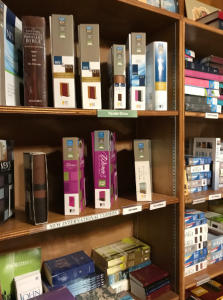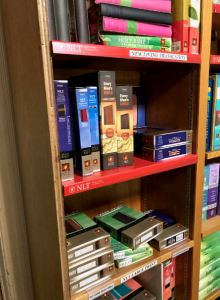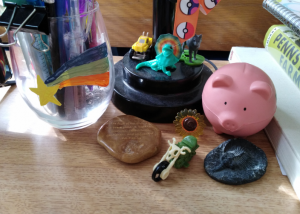When entering Bible Depot, the feeling of the merchandise leaning in close to whisper, “Come in, please, look around,” was close to my first experience when walking into the bookstore. When the door opens the customer is faced with shelves, a wide variety of a collection rests on these shelves, the most prominent being the first communion trinkets and mementos. My only thought to the placement of these items is a convenience for those coming in, perhaps for returning customers or local churchgoers of the area. At this point, the customer is led to the right, from the commonality of customers moving right (due to most people being right-handed) but another reason is that the left pathway is through a doorway, small and seemingly more closed off than the right path.
I myself took the right path on my first-time visit to Bible Depot. This area was of more interest to me on the basis that they had trinkets that had personalized items with names on them (I tell you now, they did not have the name I was looking for at the time (Tazwell, my brother) but not to fear, they may have yours!). This is of note because shop owners will place certain merchandise to the right because of the customer traffic and the higher probability of getting customers to purchase these items. This may be something that the owner of the bookstore has thought about, but also the layout of the bookstore makes this hard to combat as the store is physically built to be that way.
Another tactic for shop owners is to have the customer move through as much merchandise as possible before checkout so that the customers are incentivized to buy more on their trip. Bible Depot uses this tactic, but the use of it is so natural as the entire store has trinkets and small items that catch the eye. The current owner, Nancy, describes the style of the store as “crunchy”. While I don’t know exactly what that means I can interpret that this bookstore has a different feel than most other bookstores. Some sections are labeled by genre but most of the shelves are filled to the brim with miscellaneous objects and things, no room for anything else to be displayed without chaos erupting. Each item seems to have found a place in every nook and cranny of the store, which gives it a nostalgically claustrophobic feel (in the best way possible). The store comes alive with objects at every corner and gives the store a personality all of its own.

One room that seems especially alive is “The Bible Room”, this is not its actual name but it is what my group has come to call it. It’s aptly named as the only things on the shelves are bibles of all sorts, stretching from children’s bibles to large print, sizes from small to large. A desk stands in the middle with bookmarks and a small instructional on how to properly open your bible. The room is small, I can stretch my arms out and worry about hitting the other side. This room almost lies at the center of the store, you have to go through three doorways to get to it like it’s nestled into the building. Being the creative writer that I am, I can see how meaning can be grasped from the fact that the Bible Room rests at the center of this place. This store, everything it has done for the community, all of it, started with little bibles handed out by the Reverend who founded the store. And the bookstore is named Bible Depot, it makes sense that one room would be dedicated to this type of book. The Bible is, metaphorically, the foundation of this store and it is also, literally, the center of the store.

While the placement of the books, and other items, is important to the overall layout of a bookstore the items themselves hold stories and sentimental weight. Look around yourself, do you see items that you got recently, maybe some you bought a while ago? Do you see an item from your childhood that you’ve held onto for all these years? What story does it contain for you, what does it symbolize?
Walter Benjamin in “Unpacking My Library” says, “Every passion borders on the chaotic, but the collector’s passion borders on the chaos of memories” (60). Benjamin points out that while books and other items have a utilitarian value, to be used and read, they also contain memories and stories that mean something to the reader (the collector). Benjamin talks of a “magic circle” that is the collector’s alone, in which items are brought into and made special by the collector.

When I first visited Bible Depot, Nancy was happy to speak with us and when we went to leave she offered us free rocks. These rocks were inscribed with phrases from the Bible. Normally, this wouldn’t hold any meaning to me, in fact, I could have not taken a rock if I truly did not want one. But I did take one (after searching for the phrase I liked the most) and when I got back to my room I displayed it on my desk with other trinkets. I took an item, seemingly with no “use” and put it in a place where I would see it daily. And now it holds that memory of the store, of Nancy, and of my group.
Peter Miller in his article “What Objects Mean” says, “The point was concisely stated by Ringelblum: If the ephemeral objects were not collected, and if the journalistic, social-science reports not commissioned, and if all of it were not preserved, then no one would believe that such a place had existed.” There is weight to the presence and preservation of books. Miller puts emphasis on artifacts from the Holocaust and the movement to preserve them to remember the past. As if the only way to capture the past is to hold onto it tightly and give meaning to objects in a memory’s place.
I believe Bible Depot captures this in a different way. It has stood as a staple for Sunbury since 1931. The building itself has seen the passage of time, it has experienced the floods just as much as the people and the people of the town give their own ideas of what Bible Depot means to them. If Bible Depot were to disappear, what would it leave behind to remember it by? The answer to that is the community it has built, the people that come in and volunteer to work, the people that shop and know Nancy personally. The bookstore gives life to the merchandise it sells and gives the items meaning, but it is the people that give meaning to the bookstore.
SOURCES
TEXT
Benjamin, Walter, et al. Illuminations: Schocken Books, 2013.
Miller, Peter N. “How Objects Speak.” Chronicle.com, The Chronicle of Higher Education, 11 Aug. 2014, www.chronicle.com/article/How-Objects-Speak/148177/.
PHOTOS
Photos by Anna Chobanoff and Brianna Simmons
FLOOR PLAN
Designed on www.thinglink.com

0 Comments